Italy is home to many of the most popular tourist attractions in the world, and all of this competition usually means that Bologna is overshadowed by bigger names such as Venice, Florence, and Rome.
Bologna has one special advantage though. You may already be familiar with the phrase “all roads lead to Rome”, but what many people fail to realize is that nearly all those roads pass through Bologna first.
Since even before the Roman Empire, the Bologna area has acted as a funnel for travelers wishing to cross the Apennine Mountains into northern or southern Italy.
What does this mean for you? It means that even if Bologna isn’t on your “official” list of cities to visit, it is very likely you will be stopping there to switch trains at some point (or you can add it to a northern Italy itinerary!).
If you come in on an early train and leave on a late one, you will have just enough time to stop for a day in Bologna and hit up some of Bologna’s most important sites.
READ ALSO: An Epic 2 Weeks in Italy Itinerary by a Local
Fair warning: you’ll be amazed that a city so neglected by tourists could have so much to share, and might just decide you have to come back to see it again.
How to Get Around Bologna
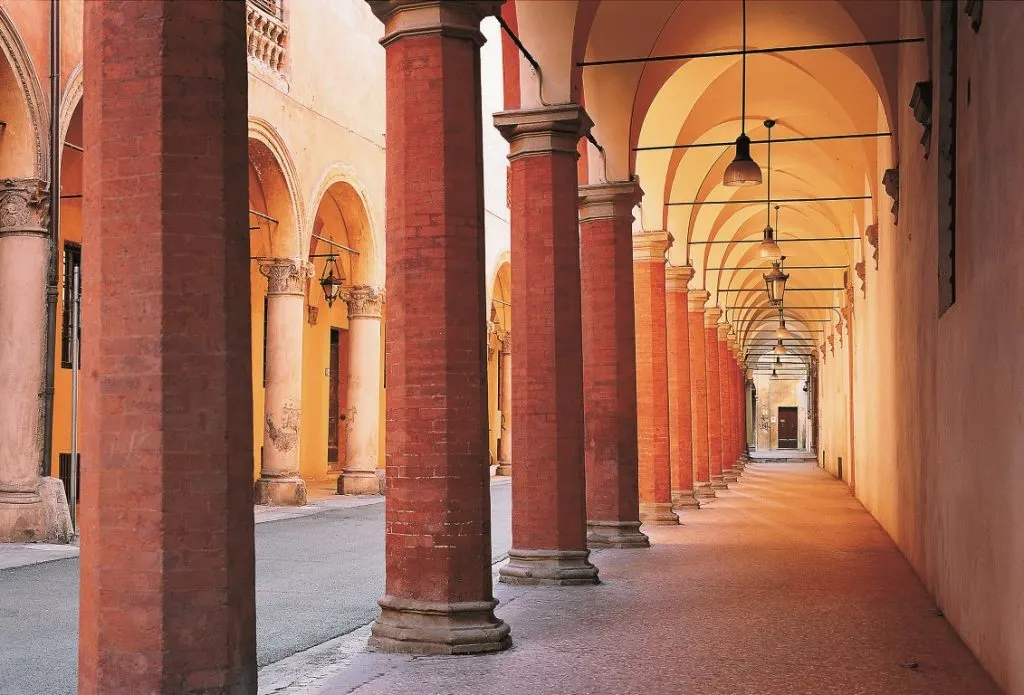
➤ Bologna has an incredibly efficient and affordable bus system called TPER (pronounced Tee-Pair), but it was truly born to be a walking city. With more porticoes than anywhere else in the whole world (38 km of porticoes in the city center alone), walkers are almost always protected from the rain and hot sun.
Indeed, you might become so spoiled by such luxurious walking space, that you will be appalled by the sad crumbling curbs that other cities deem “sidewalks” (I’m looking at you Florence).
Why exactly does the city have so many covered sidewalks? When Bologna’s University started to attract floods of students in the 11th century, locals quickly started running out of rooms to rent.
So property owners simply added extensions that jutted out over the streets, providing more student housing and simultaneously making Bologna one of the most walking-friendly cities on the planet. It was a win-win!
The city is also very compact and well-defined by the remnants of its medieval walls, so wandering around with confidence couldn’t be easier.
➤ However, if at any point you get tired, or realize you have to get somewhere in a rush, you can always take a bus. Walk into a Tabacchino (a corner store, traditionally a tobacco store, easily identified by big blue signs marked with a large white “T”) and ask for “un biglietto urbano” which is valid for 1 hour.
The bus stops are easy to find on Google Maps, which provides accurate schedules and routes.
One Day in Bologna Itinerary
When you only have one day to discover an entire city, time is at a premium and every traveler has different interests and priorities. Luckily, all of the sites in this list are close enough together that you can almost proceed in any order you like.
However, I have listed the best things to do in Bologna, Italy, in the order that makes the most sense if you’re trying to be as efficient as possible.
This itinerary both works if you have 24 hours in Bologna, or just a layover in Bologna between trains or planes. Just follow this itinerary but don’t rush – Bologna is one of those cities to just soak in!
9 AM: Stroll Down Via Indipendenza
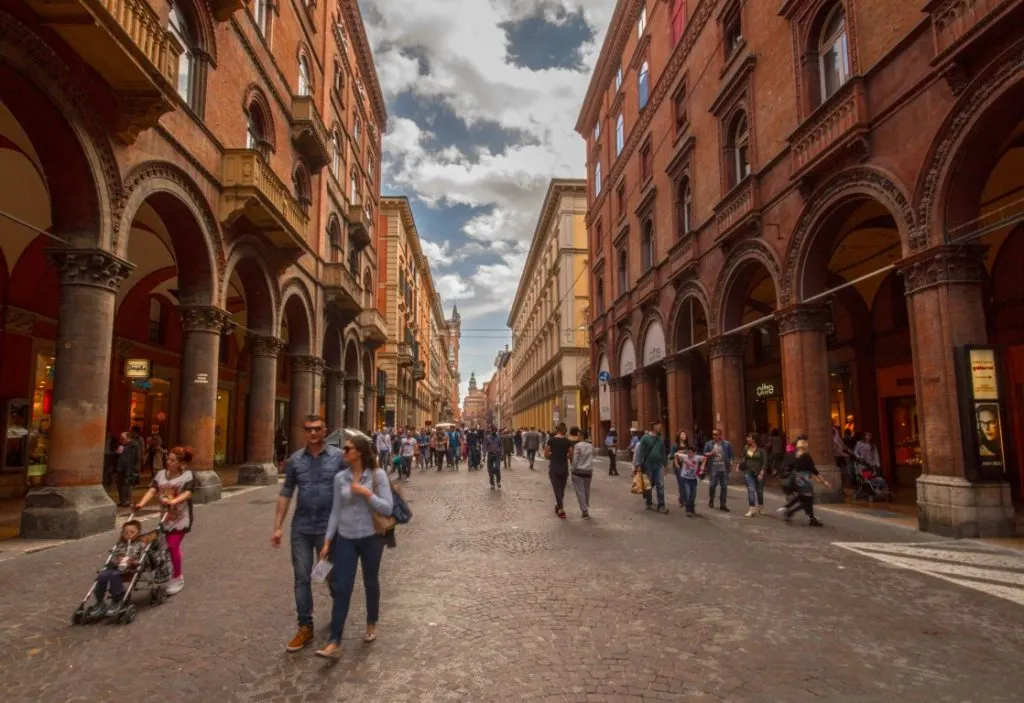
If you’re coming from Bologna Central Station, you’re within walking distance of the historical center. From the station, proceed towards Via Indipendenza. Just keep walking straight and the road will lead you to the Neptune Fountain and Piazza Maggiore, the main square.
This is a pleasurable 20-minute walk on one of the main shopping streets in Bologna, and if you visit during the weekend, the road is closed to traffic and you’ll find plenty of street artists playing music. And if it rains? No worries, you’ll be covered by the porticoes all the way!
Take a Detour to Discover Bologna’s Secret…
During the Middle Ages, Bologna was called Little Venice, and why it’s that? Bologna, like Venice today, was crossed by some canals that linked the city to the Po river.
Thanks to these waterways, Bologna was one of the richest cities in Europe: the water flow created the right conditions for many flour mills, and waterways allowed people to move faster.
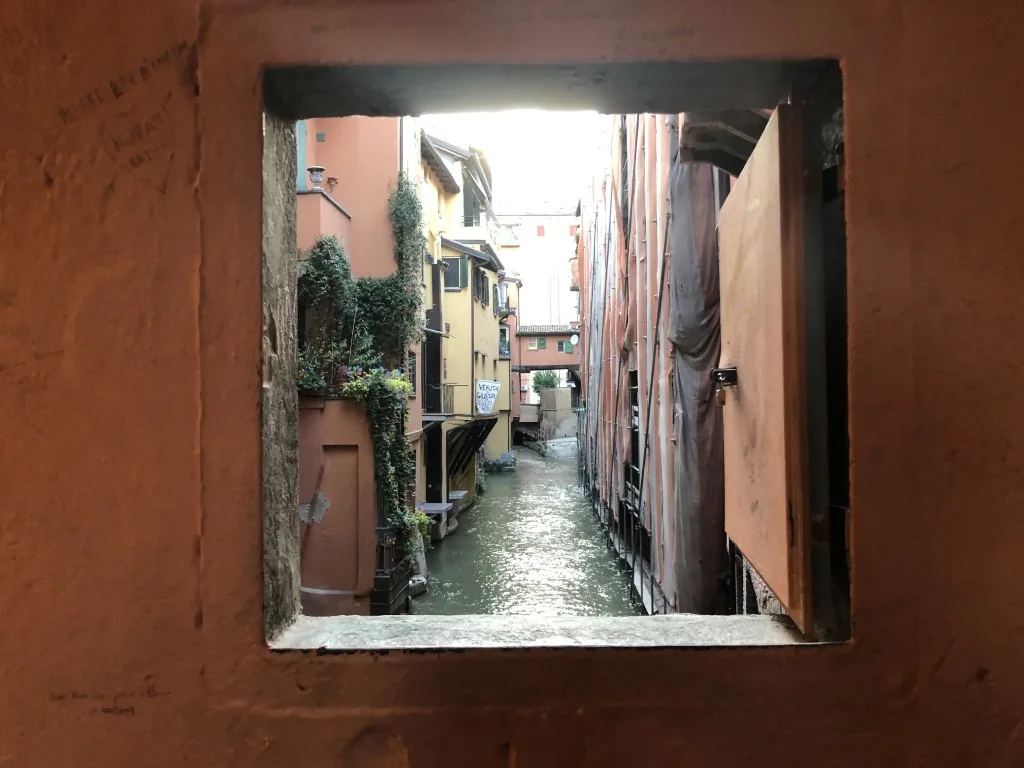
However, over the last few centuries, most of those canals were buried, and Bologna now has little in common with Venice.
Sometimes you can still hear the sound of water running but you can’t see it unless you’re in Via Piella 5 where you can still find a little window and if you open it, you’ll be surprised by the view of a waterway that passes between two buildings, right in the center of the city.
There are just a few other spots in the city where you can see the old canals, including Via Oberdan 32, and Via Malcontenti 4/c.
Bologna has quite a few fun stories and legends, check out also my post about the 7 secrets of Bologna.
10 AM: Take a Look at the Fountain of Neptune
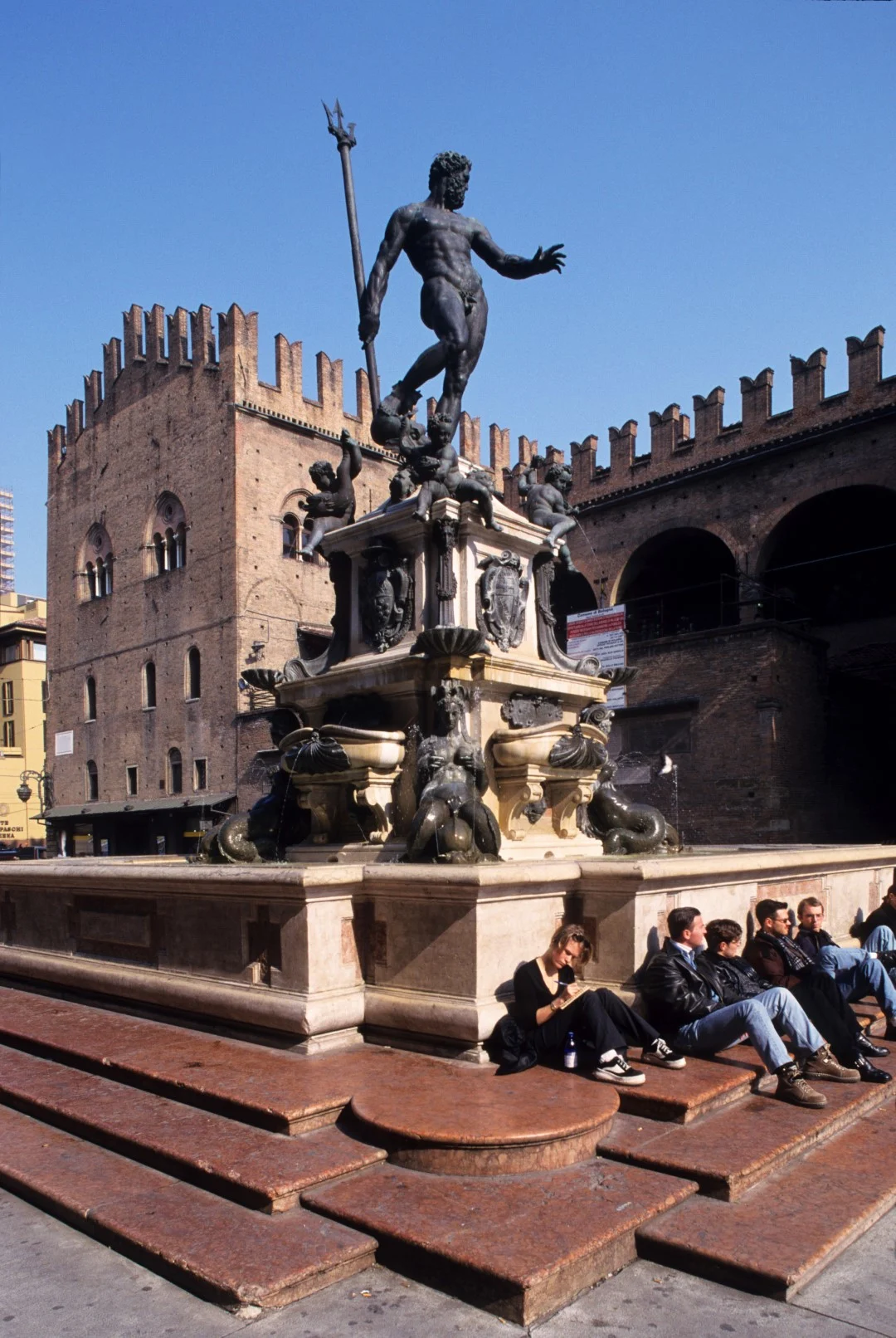
It’s time to check out one of the city’s most popular meetup spots: the Fountain of Neptune.
A statue of a sea god might seem a bit out of place here in landlocked Bologna. However, you’ve already seen there is actually a great deal of water hidden beneath the city, the canals that once played a crucial role in powering mills, and Bologna’s world-famous industrialized silk production. A fountain honoring the power of water doesn’t sound too strange now, does it?
The fountain was built in 1565, right next to the Piazza Maggiore market. All that remains now of the market is the large white stone mounted into the wall nearby, displaying the legal standards for lengths, bricks, and roof tiles. Once though, the piazza was full of vendors and shoppers.
The problem? What do you think happened when hundreds of people buying fruits and vegetables discovered a fresh source of water right next to the market? The poor fountain was quickly abused, and the delicate tubes were inevitably damaged.
The city ended up putting a wall around it with four smaller fountains so that anyone desperate to wash off their produce would use them instead.
When the market in Piazza Maggiore was discontinued the walls were removed, but one of the small fountains was left to provide free drinking water. Oh, by the way, don’t forget to fill up your water bottle!
Do you want to know another secret? This is pretty R- rated, but here we go. If you stand behind the statue of Neptune, near the steps of the Salaborsa library, the thumb of the left hand of Neptune will look like…well… his erect penis.
People say it was made on purpose as a joke by Giambologna, the sculptor of the fountain, but who knows? It’s definitely still a source of giggles for first-time visitors after all these centuries.
READ ALSO: The 7 Secrets of Bologna
10:30 AM: Visit the Roman Ruins at Sala Borsa
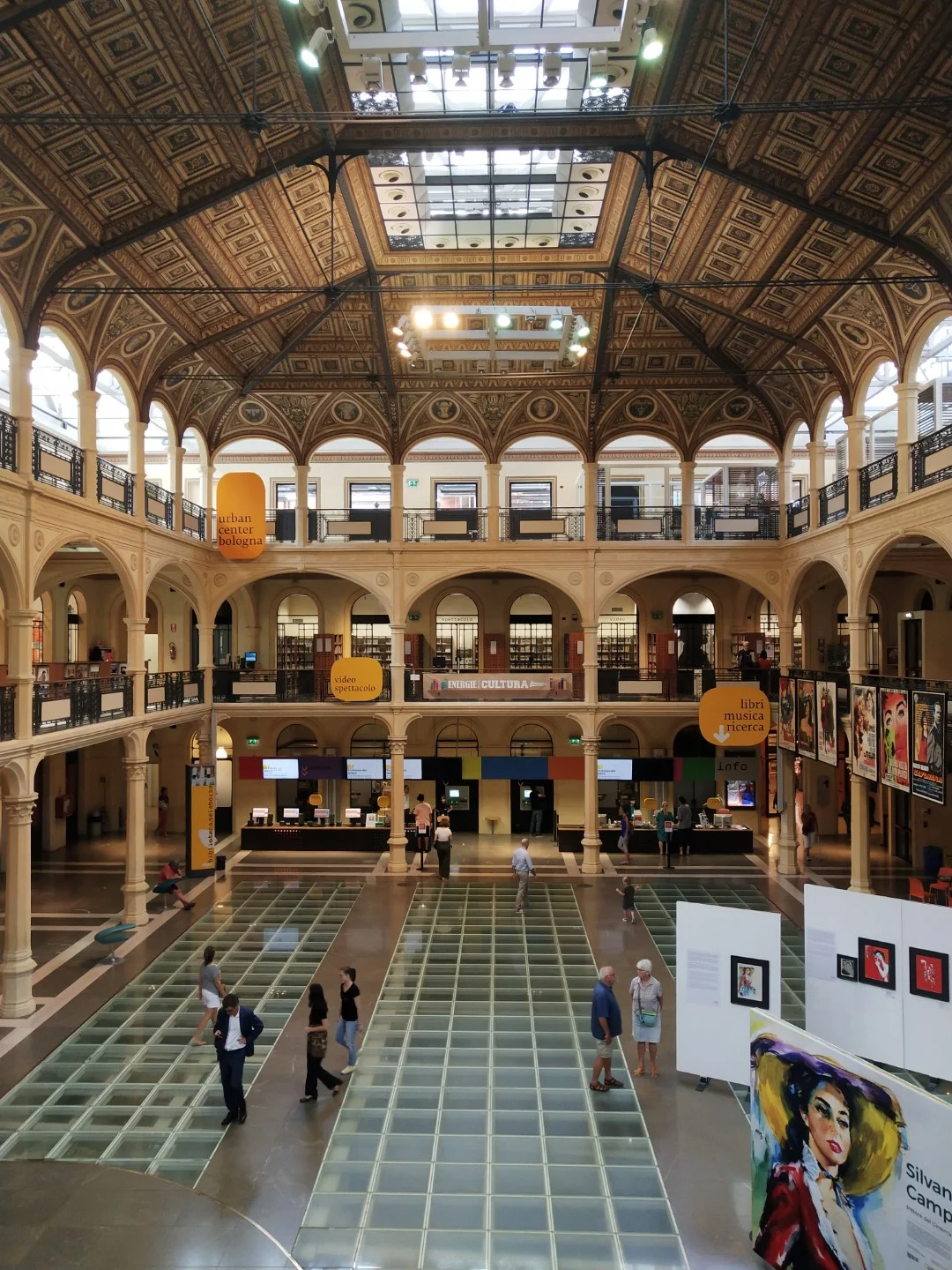
This building has played many roles throughout history: a Roman temple, a botanical greenhouse, a basketball court, and even a stock exchange (this is the literal meaning of “Sala Borsa” in Italian).
Now, it’s a gorgeous public library, with a transparent floor in the main atrium to show off its ancient Etruscan and Roman foundations.
To see the ruins up close, go down the stairs at the southeast corner of the atrium and look for a sign that says “scavi archeologici”.
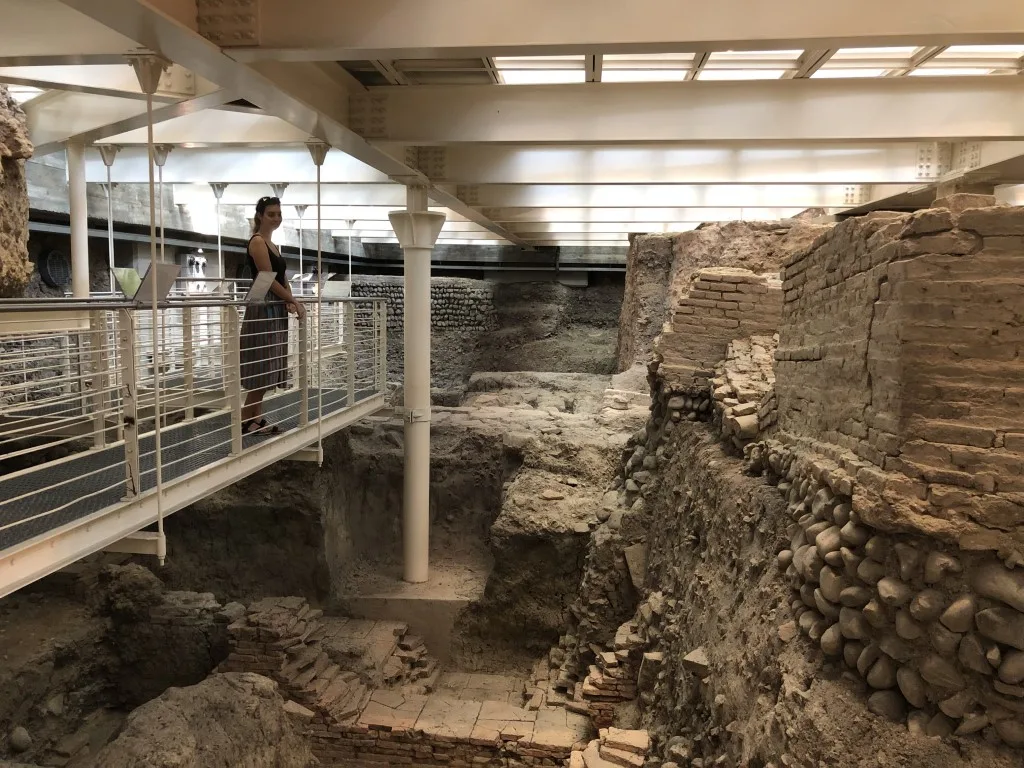
It’s free to visit the ruins, but a donation is suggested.
If you still need breakfast, the library cafè takes up a whole wall of the atrium and is the perfect place to sit and admire the architecture while sipping a cappuccino. The prices are very reasonable too.
11:30 AM : Check Out Re Enzo Palace
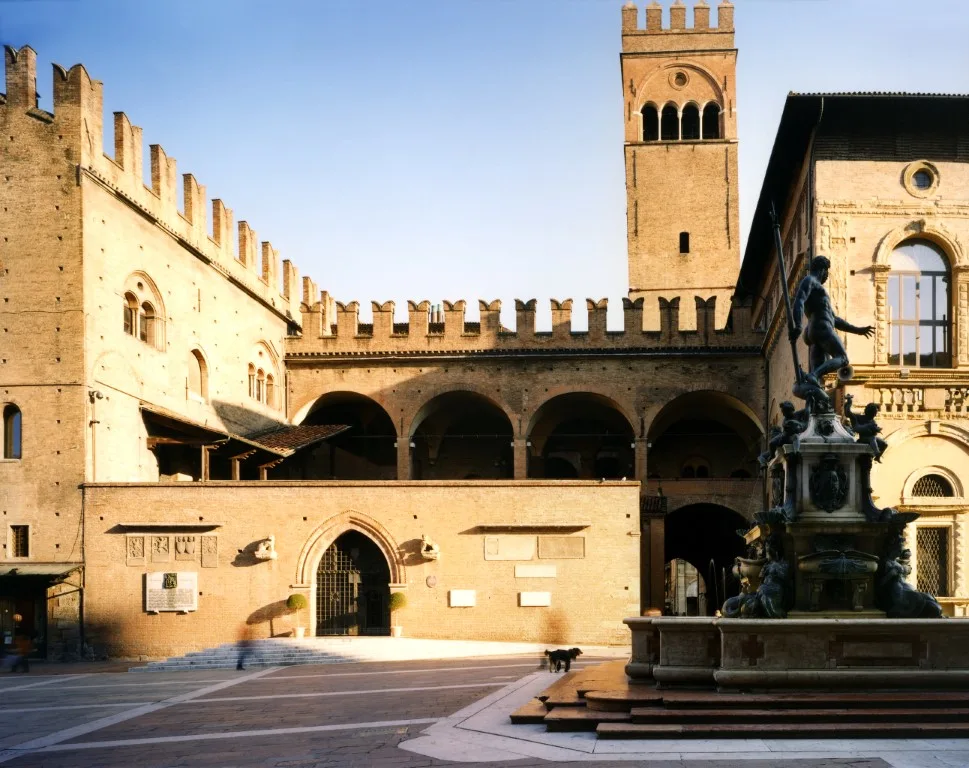
Facing the Salaborsa from the other side of the Neptune Fountain is Palazzo Re Enzo (Re Enzo Palace). This “Palace” was actually a prison for a single man, Enzio of Sardinia, son of Bologna’s rival Frederick II.
Though rumors were spread about his brutal treatment, he actually had a pretty comfortable life within the palace’s spacious halls, holding decadent parties and entertaining plenty of lady friends.
Walk around the Neptune Fountain and pass under the palace to discover a special treat: a vaulted intersection. Not only does this spot provide a stunning view of Basilica di San Petronio, but it has another fun secret.
To discover it, choose one of the corners of the vault and have a friend take a spot at the other side diagonal to you. If you both turn into the corners as if in a time-out, your voices will magically bounce across the space, allowing you to hold a private conversation from opposite sides of the vault.
A quick detour before heading into Piazza Maggiore: walk straight across the vaulted intersection (with San Petronio passing on your right) until you see a big green abandoned storefront on your right.
This used to be “Albergo Diurno Cobianchi”, a convenient “Day Hotel” where people traveling for business could drop off luggage, do paperwork, and even wash up before a meeting.
The sign proudly boasts that they offered showers with hot or cold water, towels, and soap. All for half an Italian lira. To put that in perspective: 2000 lira corresponds to roughly 1 euro. Open from 1911 to 1998, this little shop has become a monument to nostalgia for many Italians.
12 PM: Piazza Maggiore & Basilica of San Petronio
Piazza Maggiore is the main square in Bologna, and it’s such a pretty square. No matter if you follow this Bologna one day itinerary or you just take it as inspiration, you’ll end up here no matter what – guaranteed.
From wherever you stand in the piazza (square), you can look up and there are only beautiful, ancient buildings around it. You could sit at one of the cafes in the piazza for a coffee or a drink, but prices are generally more expensive due to the location, so make sure you check the menu.
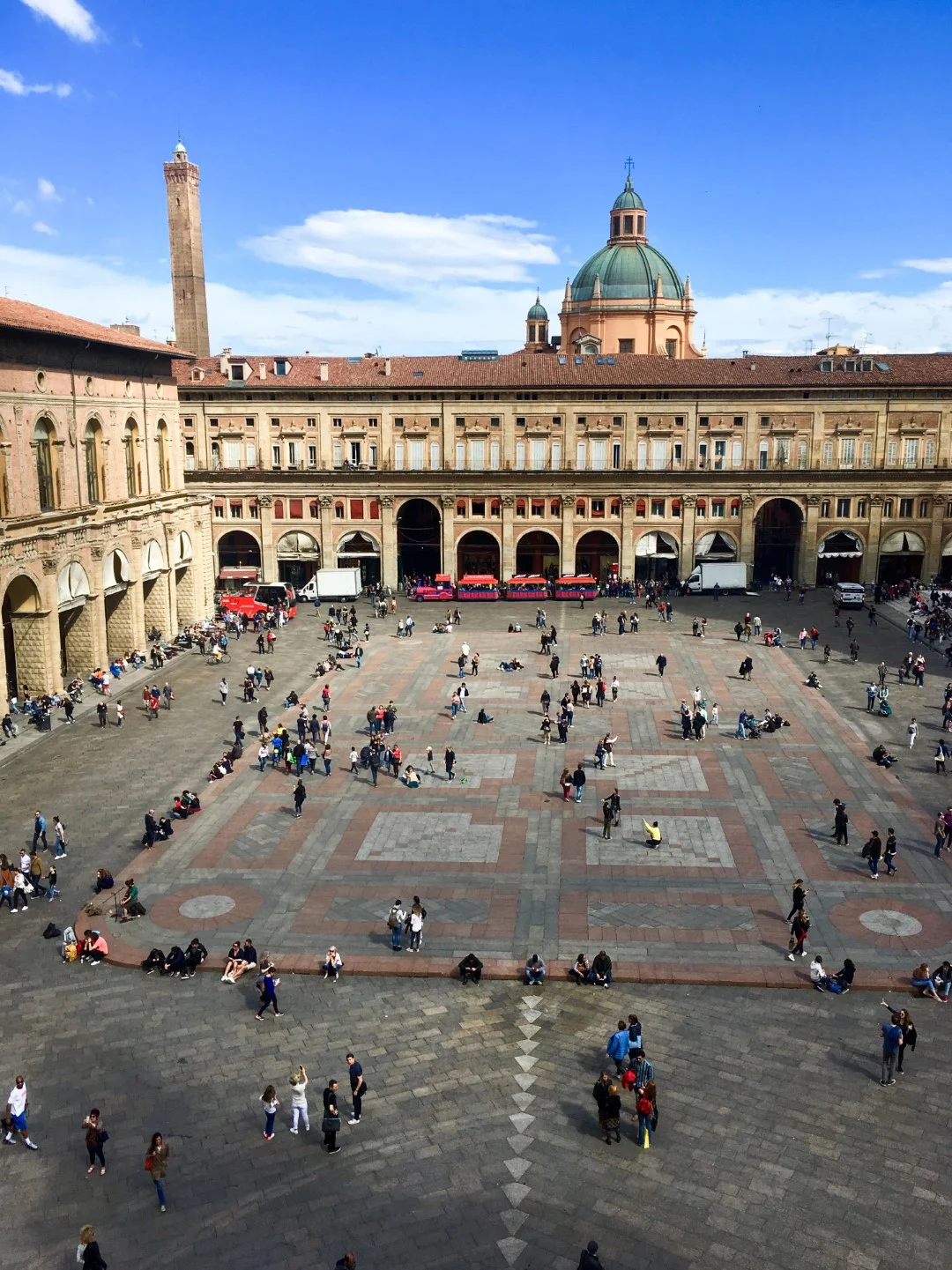
Every Italian city has a main cathedral, or “Duomo”. Usually, it has pride of place in the city center and opens onto a large piazza. So naturally, most visitors to Bologna just assume San Petronio is the Duomo.
However, Bologna’s Duomo is actually San Pietro in Via dell’Indipendenza. So why does San Petronio have such a prime location while the Duomo is stuck at the side of the street? Here’s a brief explanation.
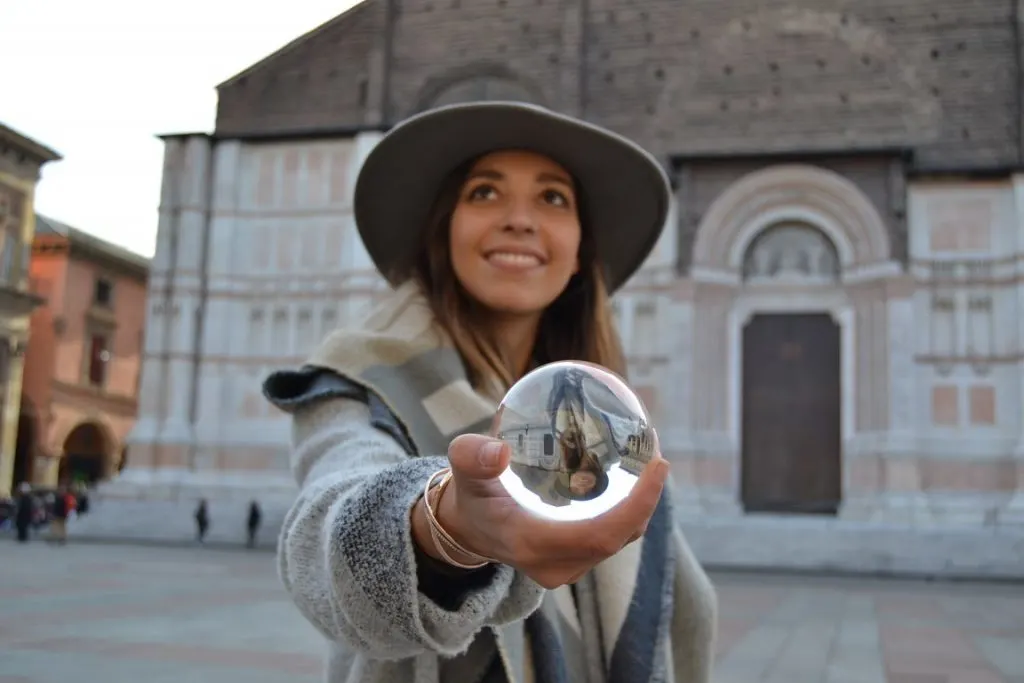
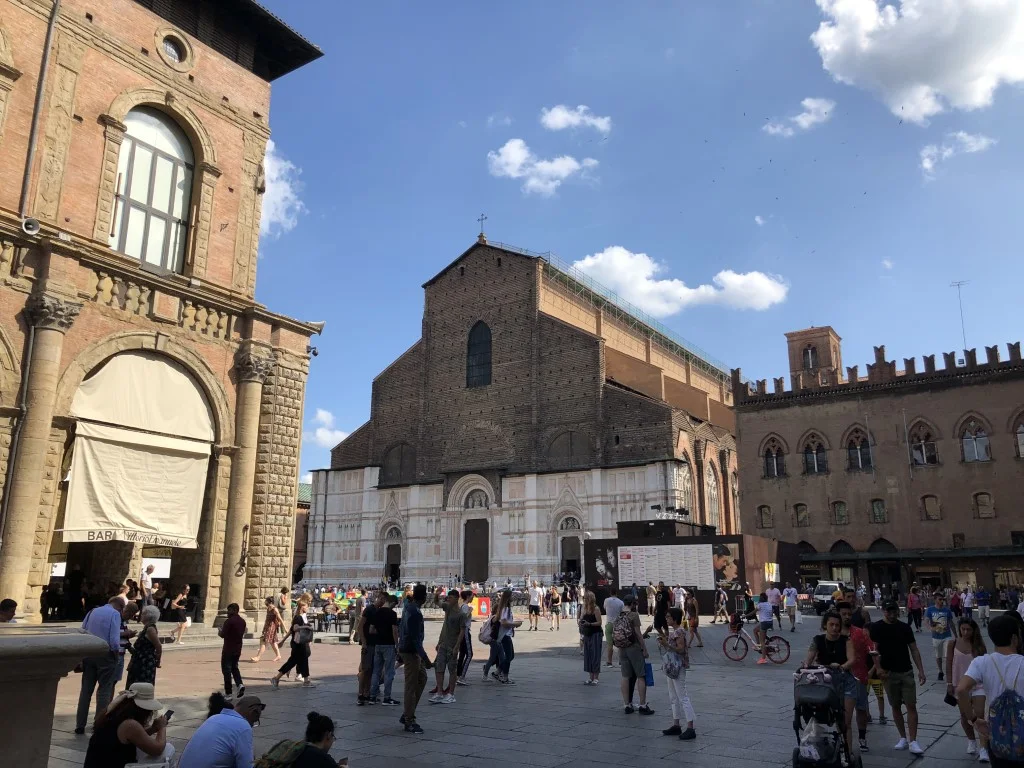
At a time when the Vatican was growing ever stronger, Bologna continued to resist Papal Power.
The Bolognese were so proud of their independence that they decided to add insult to injury by building a massive cathedral all on their own that was supposed to be bigger than the Vatican, just to show the Pope how little they needed him and his army. Construction began in 1390 and, long story short, they never finished.
Cathedrals aren’t built overnight, and when the Pope finally did take power in Bologna, enthusiasm for the project petered out. Money was tight, and the Pope certainly wasn’t going to finance a church that had been built in defiance of the Vatican.
The project’s death warrant was officially signed when Pope Pius IV commissioned builders to reclaim part of the Basilica’s land in order to build the Archiginnasio in 1562.
However, the Bolognese still love their incomplete Basilica, and there’s something fascinating about seeing one of Italy’s enormous cathedrals still “in progress”.
The inside is just as interesting as the exterior, with chapels in varying degrees of completion and decorations snaking partway across the ceiling before fading away. Among the completed works are “L’Inferno” by Giovanni da Modena and Cassini’s Meridian Line, the longest in the world.
12:30 PM: It’s a Foodie’s Dream at Quadrilatero
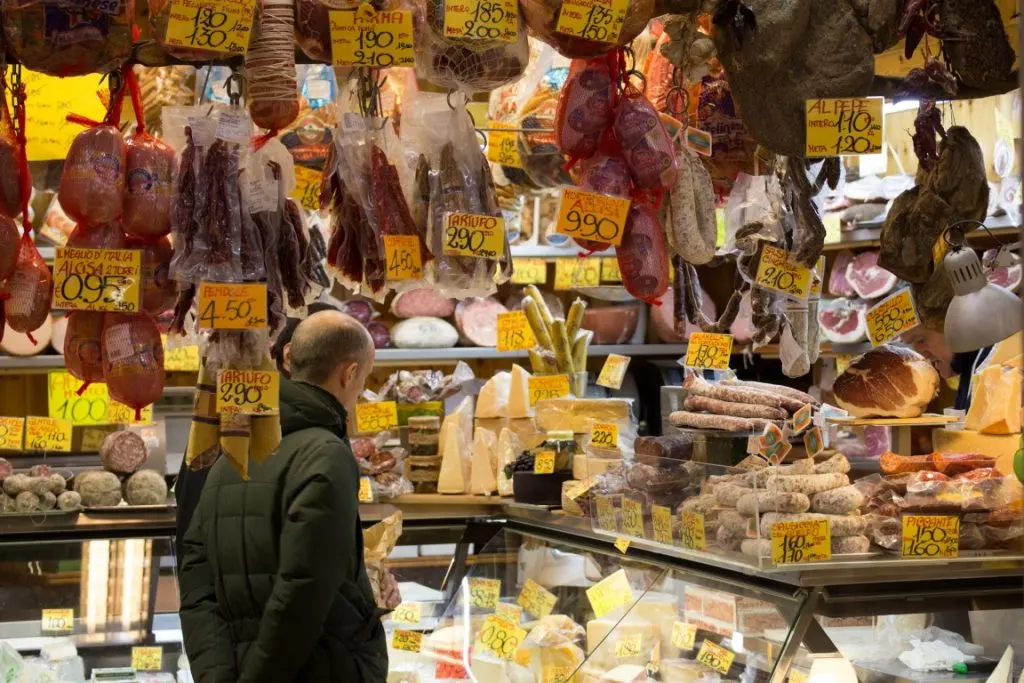
Originally home to Bologna’s fish market, over time this prime real estate has been converted into a foodie’s paradise.
Editor note: This is one of my favorite places in Bologna, and I can’t help but bringing here every first-time visitor. It’s just so traditional! When you walk down Via Pescherie Vecchie (which in Italian means “the old fish market street”), you’ll really feel like you’ve stepped in such a cliché Italian movie scene. Even if you aren’t a foodie and even if you only have one day in Bologna, Italy, this is one of those quintessentially Italian stops not to miss.
Here you can find a few old stores that sell fish, fruit and veggie, cured meats and cheese, and all the traditional Bologna food. This is where you can buy the best souvenirs for your foodie friends!
If you’re ready for some lunch, then this is the perfect place! There are plenty of options, but if you want to recreate the sensation of eating at an old market, you have to visit Mercato di Mezzo (Via Clavature 12).
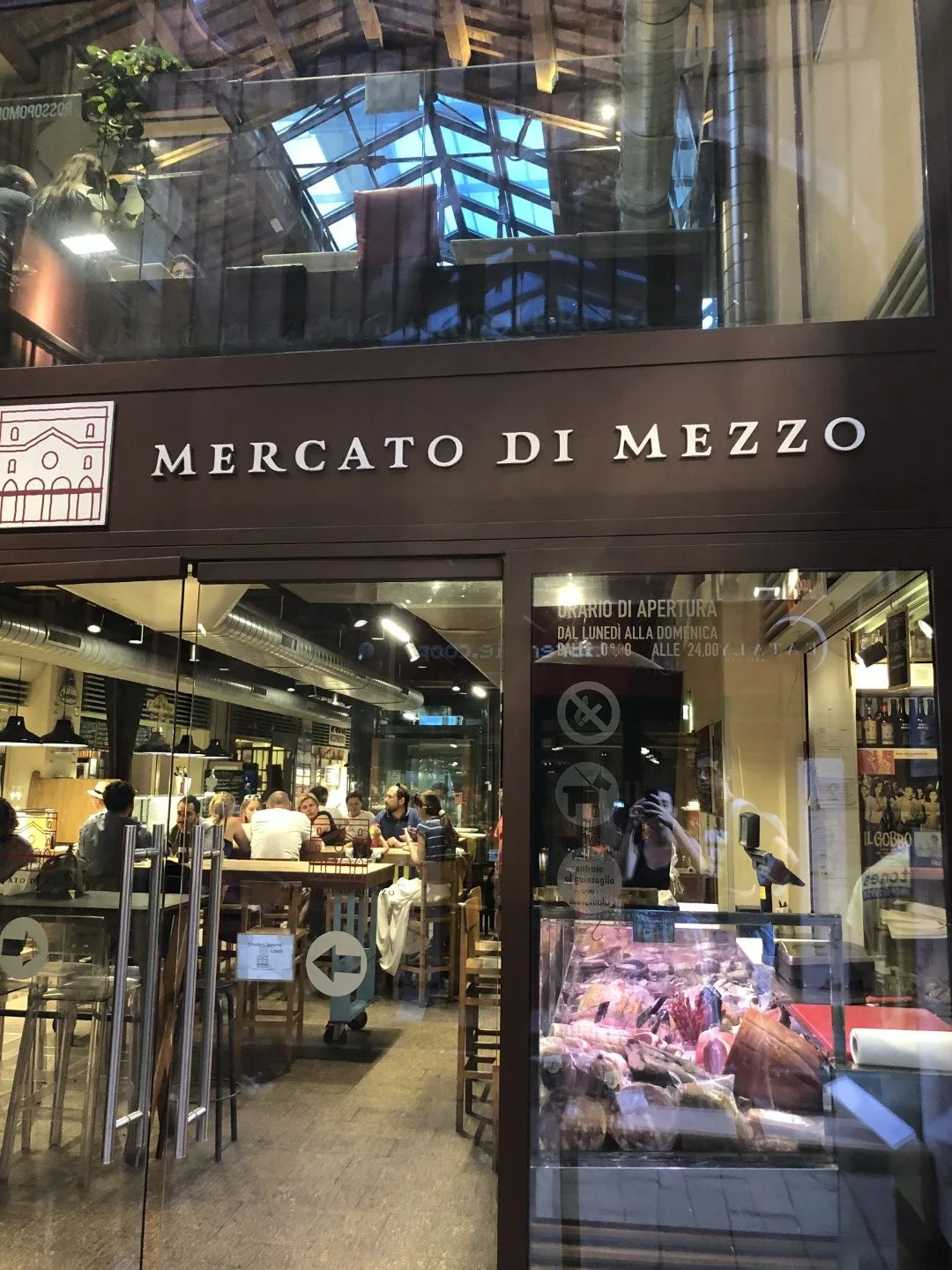
With an abundance of options, from seafood and handmade pasta to local artisanal beer and pastries, you are sure to find whatever you’re craving. If you don’t know where to start, another great alternative is to join a food tour in Bologna or maybe even a traditional cooking class!
READ ALSO: The best restaurants in Bologna chosen by a local
This area was also an international hotspot for jazz in the early 1900s, and the “Strada del Jazz” along Via degli Orefici and Via Caprarie is marked by stars set into the sidewalk, bearing the names of famous musicians who once performed here.
Obviously, the largest, most important star in the middle of the street has been dedicated to Bologna’s own musical genius, Lucio Dalla.
2:30 PM: Visit the Beautiful Archiginnasio
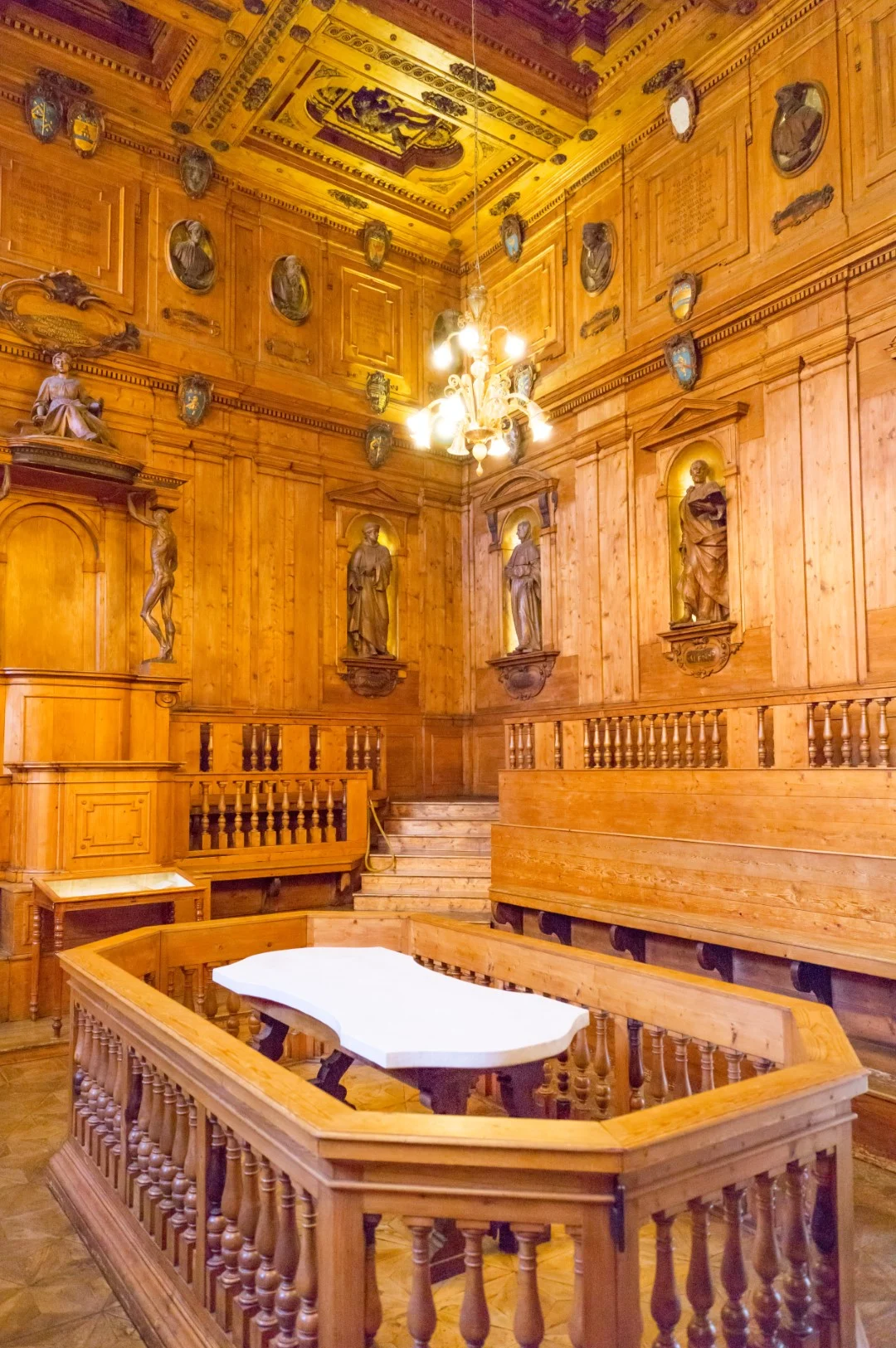
Bologna hosted the first university in the Western world, so it makes sense you’re going to visit some part of it today. The porticoes going down the east side of San Petronio will take you to the Archiginnasio palace.
As you walk, look down to see the spirals of fossilized shells in the red limestone lining the portico, and look up for a fascinating view of the jagged remains that would have been San Petronio’s east transept.
One of the University’s most important buildings, the Archiginnasio’s entrance (Piazza Galvani 1) is framed by a stunning sandstone carving. Inside, every inch of the halls has been decorated by the coats of arms of students and their proud parents.
The most famous attraction here is the 17th-century Anatomical Theatre, decorated entirely with wooden carvings and centered around an ominously expectant white table.
Opening Hours: Daily from 10 AM to 6 PM. On Sundays and holidays it closes at 2 PM.
Entrance Fee: 3 Euros.
3:30 PM: Climb the Torre degli Asinelli for some Incredible Views
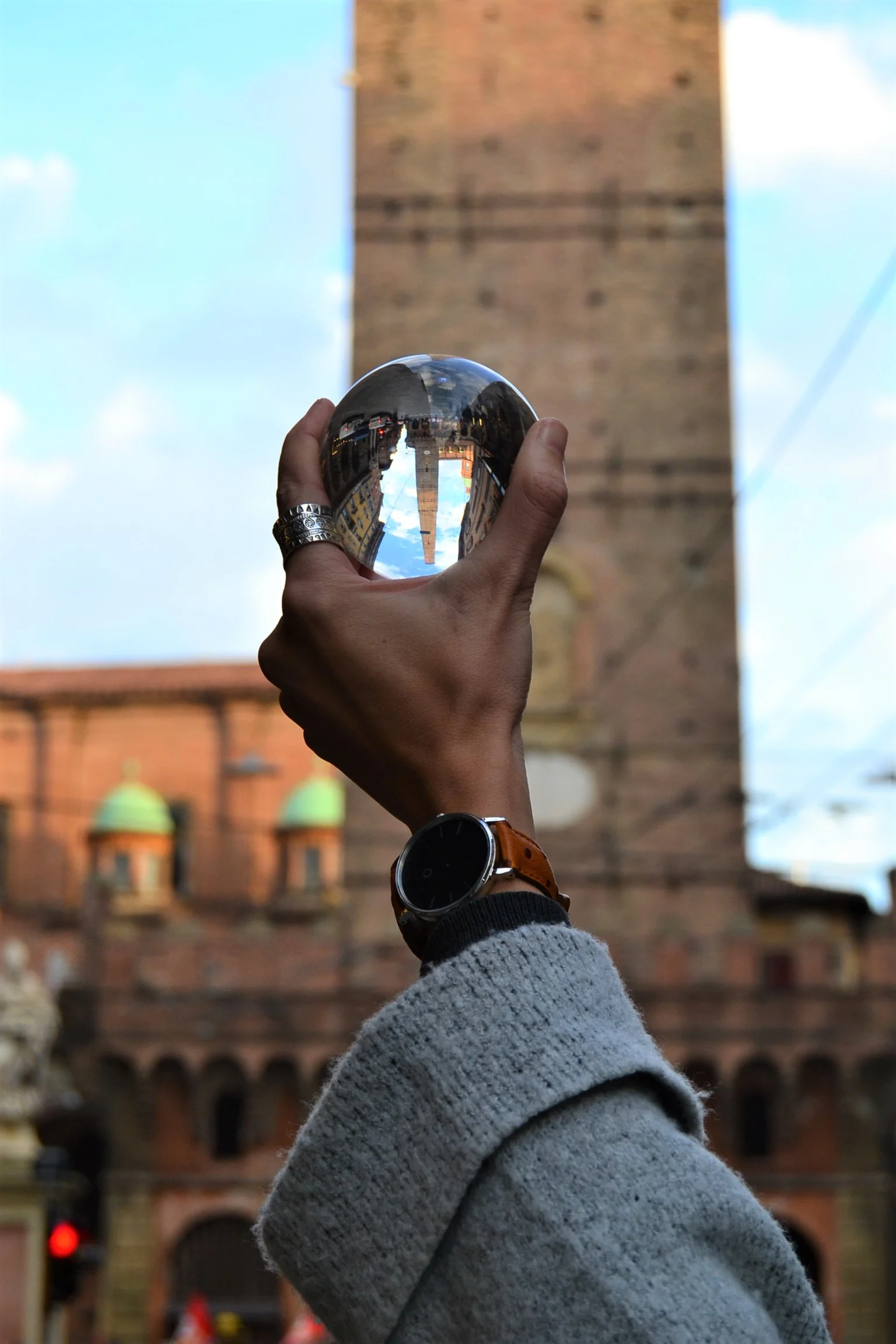
Also known as Le Due Torri (the Two Towers), these medieval skyscrapers are one of Bologna’s most famous symbols, if not the most famous.
Once known as the city of towers, Bologna’s nobility would show off their wealth and power by attempting to build the tallest tower the fastest. However, they didn’t always invest in proper construction and very few examples remain today.
Editor note: Can you believe that between the 12th and the 13th century in Bologna there were over 100 towers? It’s crazy, the city must have looked so different! Today only 22 of those towers still exist, although you probably wouldn’t notice them while walking around the city as they aren’t as tall as the two most famous ones, Torre degli Asinelli and Torre Garisenda.
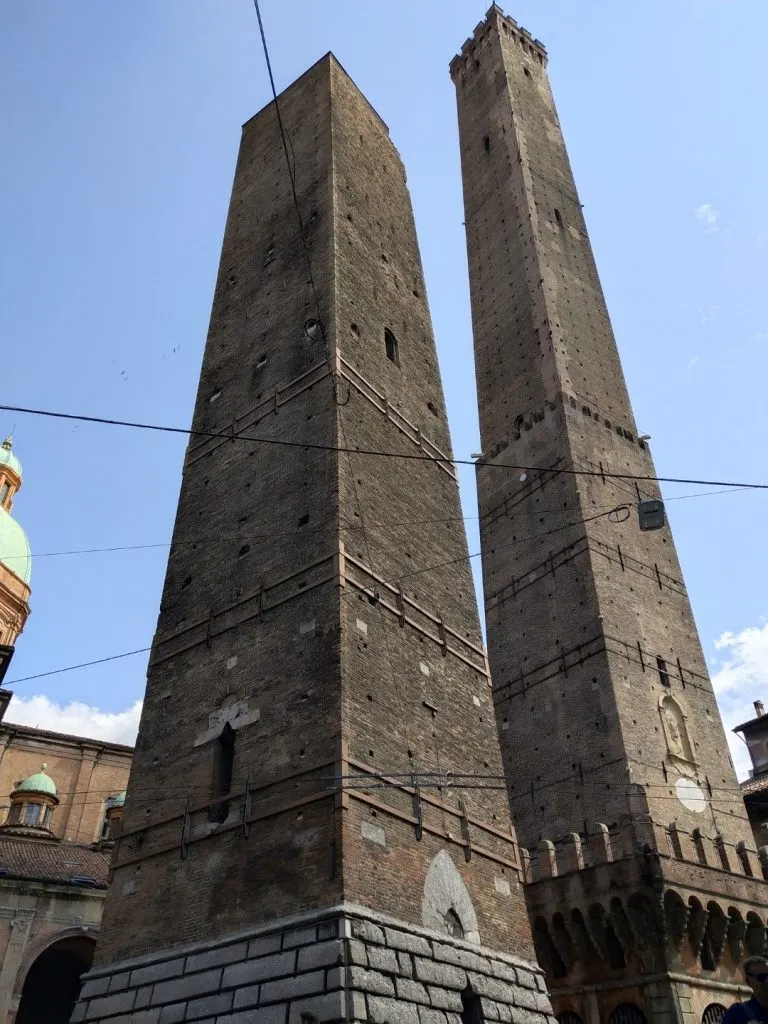
There isn’t much written evidence of the towers’ origins, but it is believed that the Torre degli Asinelli has resisted time (and gravity) so well because they were built by military commission as a lookout point.
This also explains why the two towers were built so close together. The theory is that construction started on the shorter tower, but quickly stopped when they noticed it was beginning to lean.
After investing so much time and money, it would be a shame to destroy a functional (albeit crooked) building, so they simply started over right next door in order to maintain the strategic location.
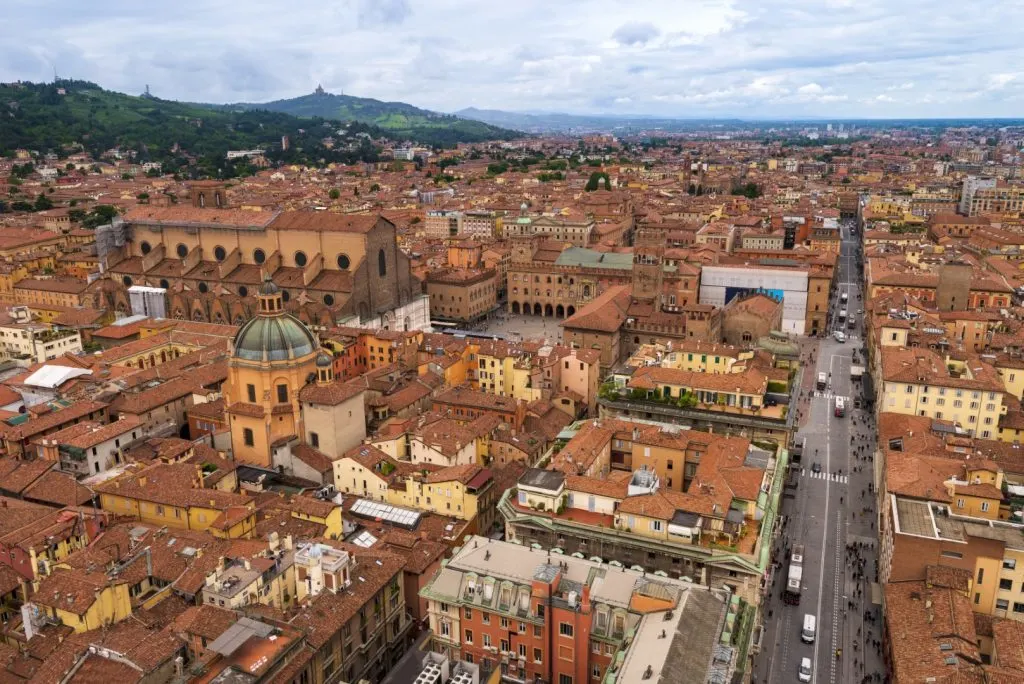
For 5 euro, you can climb the taller tower, Torre degli Asinelli, to enjoy one of the best views in Bologna, as well as catch a glimpse of the world’s longest portico snaking up to San Luca (Bologna’s favorite hilltop church). It is not possible to climb Torre Garisenda – when you see it for yourself, you’ll understand why!
Warning: the climb starts with a claustrophobic spiral staircase up to the ticket box, but don’t worry, you’ll have more breathing room the rest of the way up.
Editor note: I wouldn’t recommend the climb to elderly people or people with limited mobility because the stairs can be quite steep in certain points. I mean, the tower is taller than the famous Leaning Tower of Pisa, and 498 steps might not be a joke for some of you.
However, if you can climb it, it’s definitely one of the top things to do in Bologna in one day, so don’t be lazy!
Opening Hours: Daily from 9.30 AM to dusk.
4:30 PM: Explore Piazza Santo Stefano & The Seven Churches
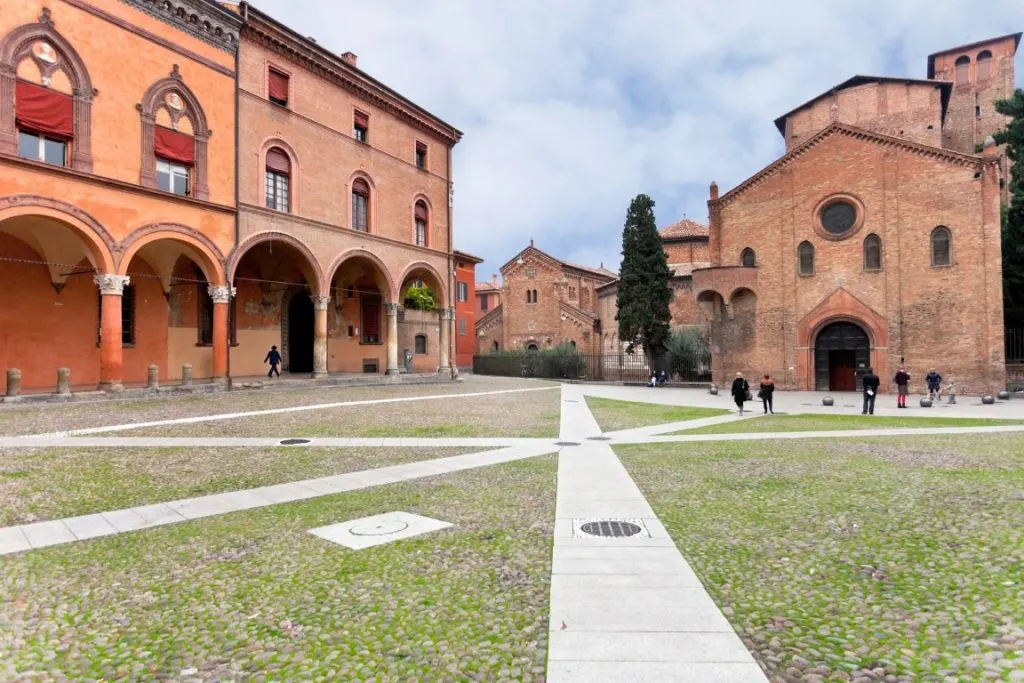
After all of those stairs, you deserve a break. You can now take a leisurely stroll over to Piazza Santo Stefano, considered by many Italians to be one of the most beautiful piazzas in Italy.
Along the way, make sure to stop at Cremeria la Vecchia Stalla (Via Santo Stefano 14/A) for a sweet pick-me-up. Here they make some of the best gelato in Bologna, and who doesn’t like gelato?! Definitely something to add to your itinerary in Bologna.
The star of the piazza is clearly the Basilica di Santo Stefano, also known as “le Sette Chiese” (“the Seven Churches”) due to the church’s unique story.
The original construction was actually a temple to the goddess Isis, which was then converted into the Basilica’s first church during the 5th century. Additions were made over time until the single church evolved into a complex of seven different buildings, all grouped together under the single name of Santo Stefano.
I highly recommend that you take a walk through the different churches, which are a spectacular testament to the evolution of religious architecture.
Opening Hours: Tuesday to Sunday from 9.30 AM to 12.30 PM and 2.30 PM to 7 PM. Closes at 6 PM in the winter.
6 PM: It’s Aperitivo Time!
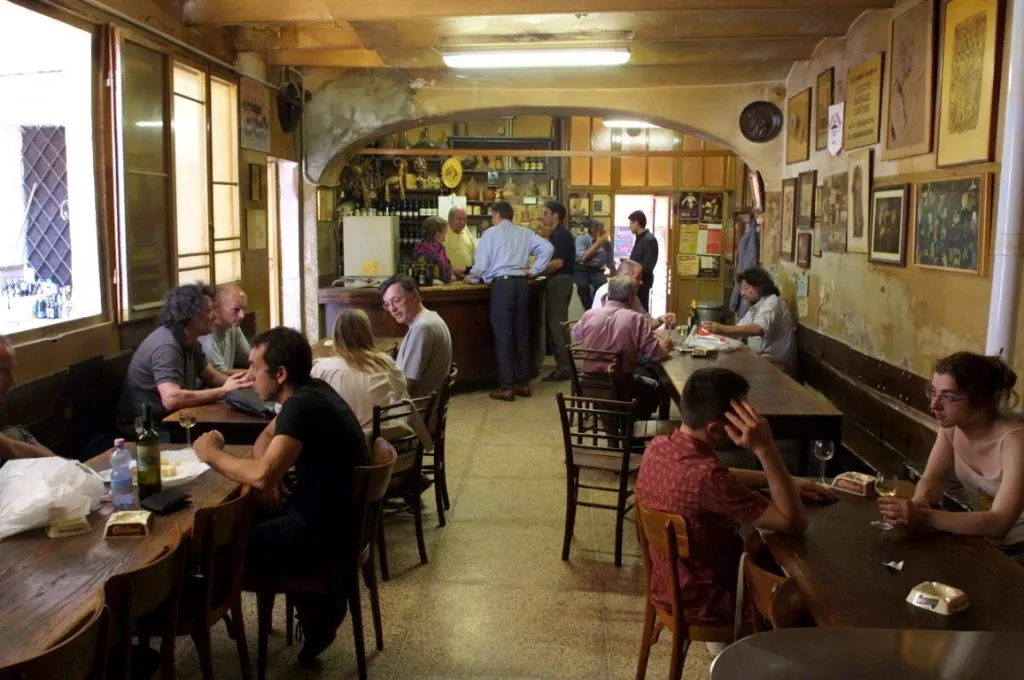
Now all that remains is to relax and enjoy Bologna’s nightlife! Grab a takeaway glass of wine from Osteria del Sole (Vicolo Ranocchi 1), which believe it or not exists since the 15th century, and wander around the Quadrilatero, enjoying the laid-back atmosphere of the Italian “passeggiata”.
Then head back towards the two towers and walk down Via Zamboni for two popular aperitivo options: Caffè Zamboni and Lab 16. Cin Cin!
Usually, you can find the aperitivo buffet until 8.30 PM or so. Walk around the University area with all the bars if you’re spending the night in Bologna, but otherwise, this should give you enough time so you can take the train to your next destination… maybe Florence or Venice?
Still hungry after the aperitivo? You shouldn’t be with those gigantic buffets, but if you still want to experience some traditional food in Bologna, check out my Bologna restaurants guide.
I hope this itinerary was useful for planning the perfect day trip to Bologna, and that you also enjoyed discovering a bit about the history of the city. For any doubts, let me know in the comments below!
This post contains affiliate links, which means if you book something through one of my links I might get a commission, at absolutely no extra cost to you

Heidi
Sunday 24th of April 2022
Hello, are you able to send me the one day Bologna itinerary in a format for me to print without the pictures?
Steph
Sunday 24th of April 2022
Hi, unfortunately I don't have the text without the pictures, but you could copy and paste it into Word and delete the images manually before printing it.
Gary
Saturday 16th of April 2022
Perfect guide for our upcoming trip. We are doing a day trip to Bologna from Florence in early June.
Steph
Saturday 16th of April 2022
I'm so glad it was useful! Enjoy! :)